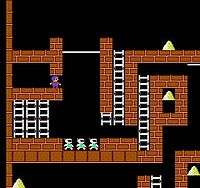Championship Lode Runner
Championship Lode Runner is a sequel to the video game Lode Runner. It consists of levels that are much more challenging than those in the original Lode Runner.
| Championship Lode Runner | |
|---|---|
 Japanese Famicom Cover art | |
| Developer(s) | Broderbund (Apple II) |
| Publisher(s) | Broderbund Hudson Soft (Famicom) |
| Designer(s) | Douglas E. Smith |
| Programmer(s) | Shinichi Nakamoto (Famicom) |
| Composer(s) | Isamu Hirano (Famicom) |
| Series | Lode Runner |
| Platform(s) | Apple II, Atari 8-bit, Commodore 64, IBM PC, NES, SG-1000 |
| Release |
|
| Genre(s) | Puzzle |
| Mode(s) | Single-player |
Gameplay

The object of the game is to pick up all the gold pieces (which appear as piles of gold) and get them to the top.[1] Using non-violent methods, enemies had to be overcome. Bumping into enemies cost the player a life and all of his hard-earned gold pieces. Fifty of the hardest levels ever designed are used and they had to be tackled in proper sequential order. While games can be saved, the player automatically loses a life for restoring his game.
Unlike the original Lode Runner game, this version did not come with a level editor. Nevertheless, many of the levels made for this game were designed using the built-in level editor from the original game.
Ports
The game was first released for the Apple II. The Apple II version allows monsters to be suppressed until they are about to appear. The Famicom port of the game was published by Hudson Soft. Unlike the Apple II version, the NES version makes their resurrection completely fatal to the player. NES players can start at any of the first ten levels while needing passwords to skip to the next levels. When stage 50, which is the final stage, is beaten, the game dumps the player straight back to the first level.
The Apple II version and NES offered players a certificate for completing the game. In Apple II version, Players sent in a code that was on the package's sticker along with a countercode (to prove that the game was beaten). In the NES version, Players sent all the passwords from stage 11 to stage 50 as the proof to Hudson Soft instead of a countercode and received a gold certificate called "Champ card".
The MS-DOS port of the game was written by Doug Greene. The IBM PC version has a playing field grid size of 26x16 blocks. In contrast, the Apple II version has levels consisting of 28x16 blocks. Hence, each level had to be manually tweaked to fit the IBM CGA screen resolution of 320x200. Although the IBM PC levels are not 100% equivalent to the Apple II levels, they were designed to be very similar with the same overall solution.
In 1985, Sega published the game for the SG-1000 in Japan and it was released on the My Card format.[2] A port was also released for the MSX. Both versions were developed by Compile.[3][4]
Reception
Based on sales and market-share data, Video magazine listed the game seventh on its list of best selling video games in February 1985.[5]
Legacy
The game can be found on a pirate NES cartridge under the names Super Load Runner or Load Runner 2.
References
- "Advanced game overview". Gamasutra. Retrieved 2010-06-08.
- "ソフトウェア一覧: SG-1000". Sega. Retrieved 2020-01-19.
- "COMPILE GAME HISTORY -SG-1000-". Compile. Archived from the original on 2002-10-03. Retrieved 2020-01-19.
- "COMPILE GAME HISTORY -MSX-". Compile. Archived from the original on 2002-10-03. Retrieved 2020-01-19.
- Ditlea, Steve; Onosco, Tim; Kunkel, Bill (February 1985). "Random Access: Best Sellers/Recreation". Video. Reese Communications. 8 (11): 35. ISSN 0147-8907.